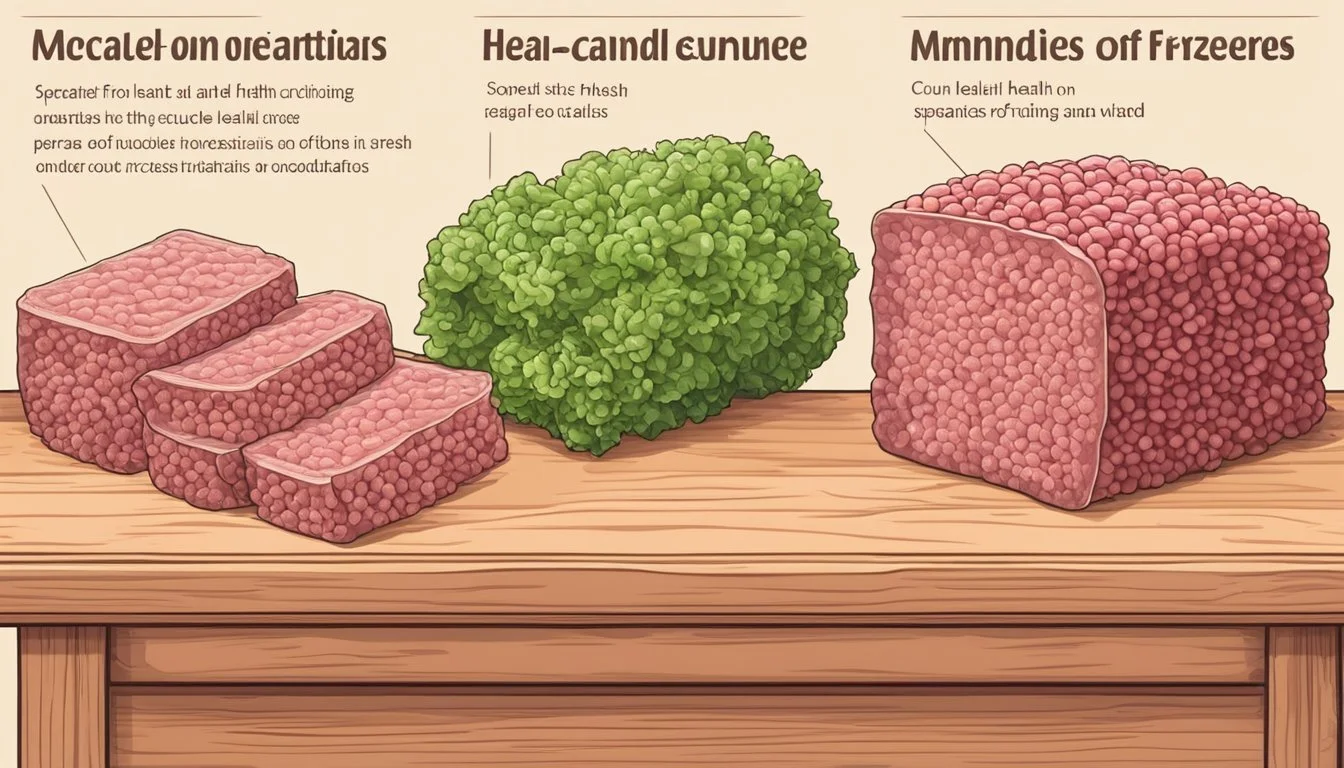Frozen vs Fresh Mince: The Ground Meat Showdown
Mince, a versatile staple in many kitchens, comes in both fresh and frozen varieties. Many home cooks wonder about the differences between these options and which is best for their culinary needs. Fresh mince typically offers a firmer texture and slightly better flavor, while frozen mince provides convenience and a longer shelf life.
The choice between fresh and frozen mince often comes down to personal preference and practical considerations. Fresh mince from a butcher is typically prepared daily and should be used within a few days of purchase. Frozen mince, on the other hand, can be stored for months and thawed when needed, reducing food waste and providing flexibility in meal planning.
Nutritionally, fresh and properly frozen mince are quite similar. While fresh mince starts with a higher nutrient content, frozen mince can retain its nutritional value if processed and stored correctly. Both types of mince can be used interchangeably in most recipes, with minimal adjustments to cooking times and methods.
Comparing Fresh and Frozen Mince
Fresh and frozen mince offer different qualities in terms of texture, flavor, and nutritional content. Both options have advantages depending on storage needs and intended use in cooking.
Quality and Nutritional Differences
Fresh mince typically contains higher levels of certain nutrients compared to frozen varieties. Vitamin content, particularly B vitamins, tends to be slightly higher in fresh mince. However, the difference is often minimal and not nutritionally significant.
Frozen mince can maintain its nutritional value for longer periods when properly stored. The freezing process helps preserve proteins and minerals effectively. Fat content remains relatively stable in both fresh and frozen mince.
Quality depends on factors beyond freezing. Fresh mince should be bright red and used quickly to prevent spoilage. Frozen mince can maintain quality for months when packaged correctly to prevent freezer burn.
Texture and Flavor Profiles
Fresh mince generally has a firmer texture and releases less liquid during cooking. This can result in a meatier bite and less shrinkage in the pan. The flavor of fresh mince is often described as more robust and "meaty."
Frozen mince may have a softer texture due to ice crystal formation during freezing. This can lead to more moisture release when cooking. Some consumers find the flavor of frozen mince slightly less intense than fresh.
Cooking methods can impact texture and flavor differences. Slow cooking tends to minimize disparities between fresh and frozen mince. In quick-cooking recipes, fresh mince may hold its shape better.
Aspect Fresh Mince Frozen Mince Texture Firmer Softer Flavor More intense Slightly milder Moisture Less release More release Cooking Holds shape better May break down more
Health Considerations
Choosing between frozen and fresh mince involves important food safety and nutritional factors. Proper handling and preparation are crucial for both types to minimize health risks and maximize dietary benefits.
Bacterial Risks and Food Safety
Frozen mince can harbor bacteria if not handled properly during thawing. Thaw in the refrigerator, never at room temperature. Cook thoroughly to an internal temperature of 160°F (71°C) to kill harmful bacteria.
Fresh mince is more susceptible to bacterial growth. Use or freeze within 1-2 days of purchase. Store at 40°F (4°C) or below. Avoid cross-contamination with other foods.
Both types can contain E. coli and Salmonella if contaminated. Wash hands and surfaces after handling raw mince.
Dietary Impacts of Mince Choices
Frozen mince may contain additives for preservation, potentially increasing sodium content. Check labels for added ingredients.
Fresh mince typically has no additives but may have a higher fat content if not trimmed. Choose lean cuts for lower calorie and fat intake.
Nutritional content is generally similar between frozen and fresh mince when comparing the same cut and fat percentage.
Frozen mince can be convenient for portion control, potentially aiding in calorie management for weight-conscious diets.
Both types provide protein, iron, and B vitamins essential for a balanced diet.
Best Practices for Storing Mince
Proper storage techniques are crucial for maintaining the quality and safety of mince meat. Following recommended practices for freezing, thawing, and refrigeration helps preserve flavor and extend shelf life.
Freezing and Thawing Techniques
Freeze mince as soon as possible after purchase to lock in freshness. Divide it into portion-sized amounts and wrap tightly in freezer bags or airtight containers. Remove excess air to prevent freezer burn. Label packages with the date and use within 3-4 months for best quality.
When thawing, transfer frozen mince to the refrigerator 24 hours before use. This gradual method prevents bacterial growth. For quicker thawing, place sealed mince in cold water, changing every 30 minutes. Avoid thawing at room temperature.
Microwave thawing is fast but requires immediate cooking. Use the defrost setting and cook thoroughly right after thawing.
Maximizing Shelf Life and Quality
Store fresh mince in the coldest part of the refrigerator, typically the bottom shelf. Keep it in its original packaging or an airtight container. Use within 1-2 days of purchase for optimal freshness.
Cooked mince lasts 3-4 days in the refrigerator. Cool it quickly and store in shallow containers to speed chilling. Reheat thoroughly to 165°F (74°C) before consuming.
To maintain quality, avoid repeatedly freezing and thawing mince. This can lead to moisture loss and texture changes. Only freeze mince once, preferably when fresh.
Economic Aspects
The economic considerations of fresh versus frozen mince extend beyond simple price comparisons. Factors like retail pricing strategies and consumer perceptions influence purchasing decisions.
Cost Comparison Between Fresh and Frozen
Fresh mince typically costs more than frozen at supermarkets. A 500g pack of fresh beef mince averages £3-£4, while the frozen equivalent is often £2-£3. Butcher shops may charge £5-£6 for premium fresh mince.
Frozen mince offers cost savings through bulk purchasing and longer storage. Many retailers sell larger 1kg bags of frozen mince for £4-£5, reducing the per-gram price.
Quality can vary between fresh and frozen. Some consumers perceive fresh as superior, justifying the higher cost. However, flash-freezing technology helps preserve nutrients in frozen mince.
Understanding Meat Pricing at Retailers
Supermarkets price fresh mince competitively as a staple item. Loss-leader tactics may be used to attract customers. Promotional deals like "3 for £10" on fresh mince packs are common.
Frozen mince pricing is more stable. Retailers like Iceland specialize in frozen foods, offering consistent low prices on frozen mince year-round.
Seasonal factors affect fresh mince prices. Summer barbecue demand can drive up costs. In contrast, frozen mince prices remain relatively constant.
Butchers often charge premium prices for fresh mince. They emphasize quality, provenance, and personalized service to justify higher costs compared to supermarkets.
Cooking with Mince
Mince is a versatile ingredient that can be used in countless dishes. Whether using fresh or frozen mince, proper cooking techniques and recipe adaptations can yield delicious results.
Recipe Adaptations for Frozen Mince
When cooking with frozen mince, thawing isn't always necessary. Add frozen mince directly to a pan on medium-low heat. Break it up with a utensil as it defrosts. This method works well for dishes like bolognese or chili.
For recipes requiring shaped mince, like meatballs or burgers, thaw the mince first. Place it in the refrigerator overnight or use the defrost setting on a microwave.
Adjust cooking times when using frozen mince. It may take 10-15 minutes longer to cook through completely. Use a meat thermometer to ensure it reaches a safe internal temperature of 160°F (71°C).
In slow cooker recipes, frozen mince can be added directly. Increase the cooking time by 1-2 hours to compensate for the frozen state.
Techniques for Enhancing Flavor
To boost flavor in mince dishes, start by browning the meat. This creates a rich, caramelized taste. Use high heat and avoid overcrowding the pan for best results.
Add aromatic vegetables like onions, garlic, and celery. Sauté them before adding the mince to build a flavorful base.
Experiment with different herbs and spices. Dried herbs work well in long-cooked dishes, while fresh herbs are best added near the end of cooking.
Deglaze the pan with wine or stock after browning the mince. This lifts the flavorful browned bits from the bottom of the pan, incorporating them into the sauce.
For saucy dishes, consider using tomato paste or Worcestershire sauce to add depth. These ingredients provide umami flavors that complement mince well.
Consumer Buying Guide
Choosing the right mince is crucial for creating delicious meals. Quality, fat content, and source all play important roles in the final product.
Selecting the Best Mince
Look for mince with a bright red color and minimal browning. Fresh mince should have a fine, even texture without large chunks of fat or gristle. Avoid packages with excessive liquid.
For optimal flavor, purchase mince on the day you plan to use it. If buying in advance, store in the coldest part of the refrigerator and use within 1-2 days.
Consider the fat content based on your recipe needs. Leaner mince (5-10% fat) works well for dishes like bolognese, while fattier mince (15-20%) is ideal for burgers.
Factors to Consider When Buying Mince
Price varies between supermarkets and butchers. Supermarkets often offer competitive prices, especially on bulk packages. Butchers may be pricier but can provide fresher, higher-quality mince.
Ask about the cut of meat used. Premium mince from specific cuts like chuck or sirloin can enhance flavor but cost more.
Check labels for additives or preservatives if you prefer a pure product. Some mince contains added water or preservatives to extend shelf life.
Consider buying larger quantities to freeze for later use. Flatten mince into thin portions for quicker thawing and more even cooking.



